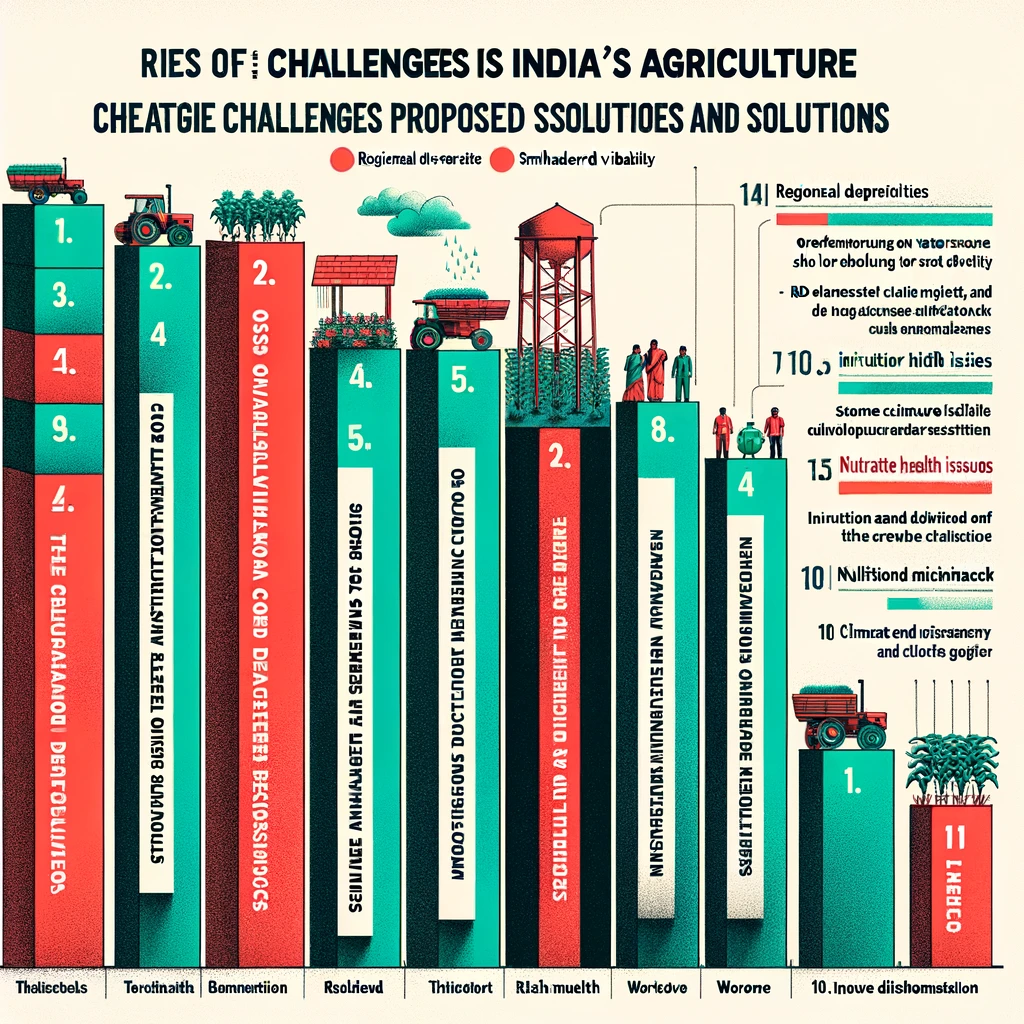Origin Of Article
This editorial, drawing from the insights of “Food for Reform” published in the Indian Express on April 15, 2024, underscores the critical need for forthcoming administrations to concentrate on bolstering agricultural productivity, amplifying processing and retailing ventures, and encouraging the uptake of innovative technologies.

India is growing fast, but many farmers are struggling. Lots of people rely on farming, but it’s not as big a part of the economy as it used to be. The government wants to help farmers and make sure farming is good for the environment too.
The Indian government has been talking about sustainable farming, which means using technology to farm in a way that’s good for nature. They want to help farmers produce more without hurting the environment.
Now, the government wants to do even more. They’re asking different departments to come up with ideas to help farmers in the first 100 days of their new term. They’re talking to experts to get the best ideas to make farming better for everyone.
Challenges in Ensuring Adequate Agri-Food Systems in India
Overexploitation of Water Resources
- Water-intensive crops grown in low-rainfall areas.
- Monoculture of paddy in traditionally non-paddy regions.
- Expansion of water-intensive crops like sugarcane, disregarding agro-climatic suitability.
Disregard for Nature and Loss of Crop Diversity
- Policy bias towards certain crops leading to decreased crop diversity.
- Significant increase in area under crops like paddy and sugarcane, disrupting traditional crop patterns.
Low Efficiency and Price-Led Growth
- Slow modernization of agricultural practices.
- Inefficient use of inputs like fertilizers and water.
- Below-par productivity levels compared to other agricultural nations.
Imbalances and Regional Disparities
- Growing imbalances between demand and domestic production.
- Surplus production of certain crops like rice, wheat, and sugar, while facing deficits in others like edible oil.
Wasteful Investment
- Significant investments in irrigation infrastructure with stagnation or decline in irrigated area.
- Delayed completion of irrigation projects due to various obstacles and disputes.
Technology Generation and Dissemination
- Complex agricultural problems necessitating capital-intensive research.
- Shrinking scope for spillover of technology from developed countries.
- Growing responsibility of ICAR over State Agriculture Universities.
Viability of Smallholders
- Dominance of small land holdings in Indian agriculture.
- Inadequate income generation from traditional farming practices.
- Need for institutional support to overcome scale economy issues.
Nutrition, Food Safety, and Health
- High levels of malnutrition and child health issues.
- India facing hunger despite being a significant exporter of rice.
- Urgent need to address nutritional security alongside food security.
Mismatch between Structural Changes in Output and Workforce
- Declining share of agriculture in national income and employment.
- Disparity in income between agriculture and non-agriculture sectors.
Low Income of Farmers
- Poor income per worker in agriculture compared to other sectors.
- Factors contributing to low income include small land holdings, excess workforce, and low productivity.
Steps to Improve Agricultural Productivity
Raising Total Factor Productivity
- Increased investment in agricultural R&D, innovations, and extension services.
Creating Climate Resilient Agriculture
- Investment in seeds and practices resistant to extreme weather conditions.
- Adoption of precision agriculture techniques for efficient water use.
Building Efficient Value Chains
- Developing logistics infrastructure to support food movement from rural to urban areas.
- Promotion of private sector investments in food processing and retailing.
Promoting Farmer Producer Organisations (FPOs) or Cooperatives
- Encouraging smallholders to join together through FPOs or cooperatives.
- Scaling up production to meet demands of processors and retailers.
Moving Beyond Simple Food Security to Nutritional Security
- Fortification of staple foods with micro-nutrients to address malnutrition.
- Need for public-private partnerships to facilitate food systems transformation.
Shift from Growth to Efficient-Growth
- Upgradation of agricultural technology and practices.
- Use of digital technology for efficient dissemination of knowledge to farmers.
Surplus Management
- Shift in food policy from shortage management to surplus management.
- Need to explore overseas markets to dispose surplus food produce.

Utilizing Technology to Enhance Food Systems and Agricultural Productivity
Enhancing Productivity
- Precision Farming
- Utilizing GPS, sensors, and drones to optimize planting, watering, and fertilizing processes.
- Higher yields and reduced resource wastage.
- Mechanization
- Introduction of machinery such as tractors, harvesters, and planters.
- Reducing manual labor and increasing efficiency in farm operations.
- Biotechnology
- Development of genetically modified crops with enhanced resistance to pests, diseases, and environmental stresses.
- Improving yield and quality.
Improving Resource Management
- Water Management
- Implementing technology for efficient irrigation systems like drip and sprinkler irrigation.
- Conserving water and improving crop yield.
- Soil Health Monitoring
- Using sensors and imaging technology to assess soil health and nutrient levels.
- Targeted fertilization and soil conservation practices.
- Weather Forecasting
- Accessing real-time weather data for better planning and management of farming activities.
- Reducing risks from weather-related disasters.
Facilitating Market Access
- Digital Platforms
- Online marketplaces and mobile applications for farmers to access markets.
- Negotiate prices and sell produce directly to consumers.
- Eliminating middlemen and increasing profits.
- Supply Chain Management
- Implementing technology for tracking and monitoring produce from farm to market.
- Ensuring quality control and reducing wastage.
Promoting Sustainability
- Empowering Smallholder Farmers
- Providing access to information, markets, and financial services.
- Mobile applications offer agronomic advice, market prices, and weather forecasts.
- Enabling informed decisions and improving livelihoods.
- Renewable Energy
- Using solar panels and bioenergy sources to power farms.
- Reducing reliance on fossil fuels and mitigating carbon emissions.
- Data-driven Decision Making
- Analyzing data from sensors, satellites, and drones to make informed decisions.
- Predictive analytics help farmers anticipate pest outbreaks or identify optimal planting times.
- Proactive management strategies and minimizing risks.
Conclusion
To truly uplift farmers’ incomes and revolutionize agriculture, we need to completely change how we approach the sector. Outdated rules need to go, and we must open up agriculture to new ideas. This means letting science and technology lead the way, involving private companies more in every step from planting to selling, and making it easier for farmers to rent land. By doing this, we can make agriculture modern and thriving, ready to tackle the challenges of today and help build a better India.

